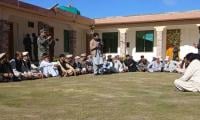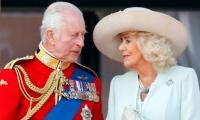Ramadi in the west.
Twelve car bombs exploded almost simultaneously around the city after dawn, with at least seven suicide bombers targeting government security installations, police said.
At least 17 people were killed and 38 wounded, according to a police lieutenant colonel and a doctor at Ramadi hospital.
The bombers included a Belgian, a Syrian, an Uzbek and one from the Caucasus, according to IS accounts monitored by the SITE Intelligence group.
An Australian teenager also reportedly carried out a suicide bombing, which Prime Minister Tony Abbott on Thursday described as “absolutely horrific”.
Clashes ensued but IS failed to gain any ground in one of the biggest attacks against a rare pocket of government control in Anbar, a vast but largely desert province bordering Syria.
“Our brave security forces were ready and had excellent intelligence about the operation,” Anbar Governor Sohaib al-Rawi said on social media.
In and around Baghdad on Wednesday, at least 17 people were killed in five attacks, including nine in a car bomb in the Hurriya neighbourhood.
Also on the offensive in Syria, the Jihadists launched a “huge assault” on Wednesday to try to capture a strategic town on the border with Turkey, killing dozens.
Their attack focused on Ras al-Ain and IS seized a nearby village, the Syrian Observatory for Human Rights said.
Observatory head Rami Abdel Rahman said the offensive was a preemptive strike against Kurdish militiamen planning to attack the IS-held town of Tal Abyad further west.
At least 12 fighters from the Kurdish People’s Protection Units, which control Ras al-Ain and surrounding villages, were killed, he said.
IS has also ramped up its propaganda war in what some analysts see as a possible sign of desperation by a movement on its last legs.
After destroying several Iraqi heritage sites that are among the planet’s most precious, the Jihadists again shocked the world on Tuesday by releasing a video in which an Arab Israeli accused of spying for Israel is “executed” by a boy who looks no older than 12.
Speaking to lawmakers, US Secretary of State John Kerry said it was a “pivotal hour” in the battle against the most violent group in the history of modern Jihad.
Appearing before the Senate foreign relations committee, he and top US defence officials appealed for a united vote in favour of a new authorisation for the use of military force against IS.
The United States leads a 60-nation coalition involved in the fight against the Jihadists and has carried out hundreds of strikes against IS in Iraq and Syria.
Iraq’s other key foreign partner Tehran backs a number of the militias fighting IS but the Pentagon is uneasy about the role of Iranian advisers in the battle for Tikrit.
Their presence “is something that is concerning to us in particular because the sectarian danger in Iraq is the principal thing that can unravel the campaign against ISIS,” US Defence Secretary Ashton Carter said on Wednesday, using another name for IS.
Iran’s top commander for external military operations, Qassem Soleimani, has been ubiquitous on Iraq’s front lines.
Comments by Iranian-backed militia commanders had stoked fears that the recapture of Tikrit could lead to widespread sectarian reprisal killings.
But so far, reports of abuses by the mostly Iraqi forces battling IS in and around Tikrit have been relatively limited.
Indigenously built Light Combat Helicopter "Prachand' during its formal induction into the Indian Air Force , in...
Prince Yakub Habeebuddin Tucy. — PTI/File NEW DELHI: Royal lineages rules India until Independence. As India...
Bangladesh’s former Prime Minister Sheikh Hasina at the Presidential Palace in Dhaka. — AFP/File DHAKA:...
Russian President Vladimir Putin and Ukrainian President Volodymyr Zelensky. — AFP/File MURMANSK, Russia: Russian...
US Vice President JD Vance, flanked by Secretary of Energy Chris Wright and US National Security Advisor Mike Waltz,...
A person holding a knife.— AFP/FileLONDON: Possessing a ninja sword is to be banned in the UK and carry a penalty of...







